For this species raising chicks is an unusually exhausting job.
On several of my camping trips to Montana’s Centennial Valley I spent much of my time photographing two species of nesting sapsuckers in nearby areas close to the Montana/Idaho border. This pair of Williamson’s Sapsuckers was raising a batch of fairly young chicks in their nesting cavity in an aspen at the edge of a dispersed USFS campsite.
I’ve covered this subject before but all but one of these photos is new to Feathered Photography.
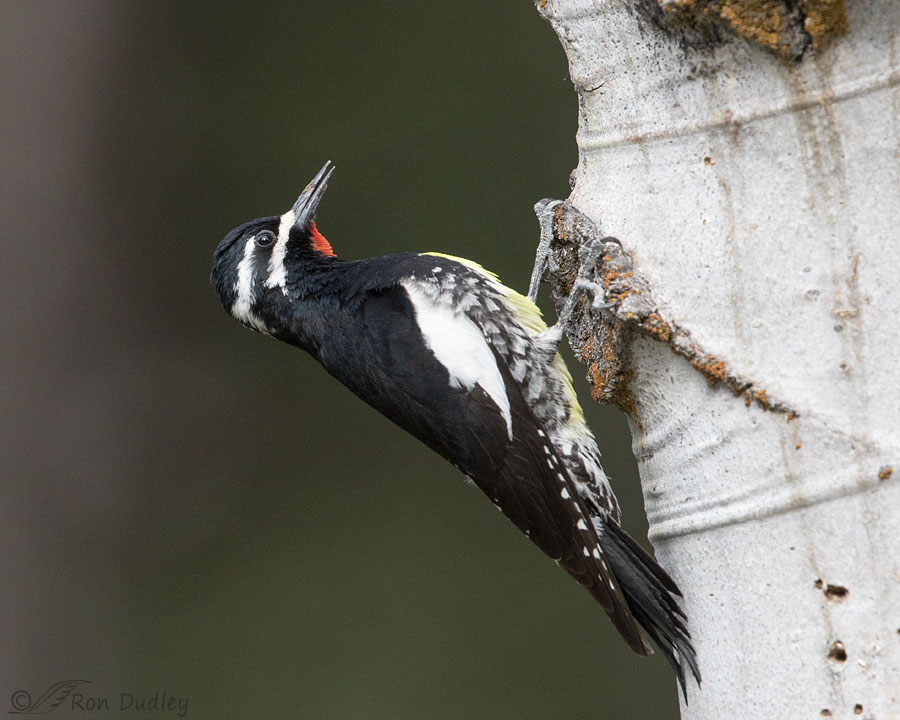
This is the male of the pair taking a brief rest as he was hanging from one of the aspen scars. Because of their habit of clinging to the side of vertical trees nearly every photo I’ve taken of a sapsucker had to be cropped vertically but this tree was leaning and the bird was hanging back far enough to allow me to crop this one horizontally. I notice stuff like that.
Williamson’s Sapsuckers exhibit far more sexual dimorphism than other woodpecker species so the sexes look very different – so much so that early naturalists were confused into thinking the two sexes were separate species.
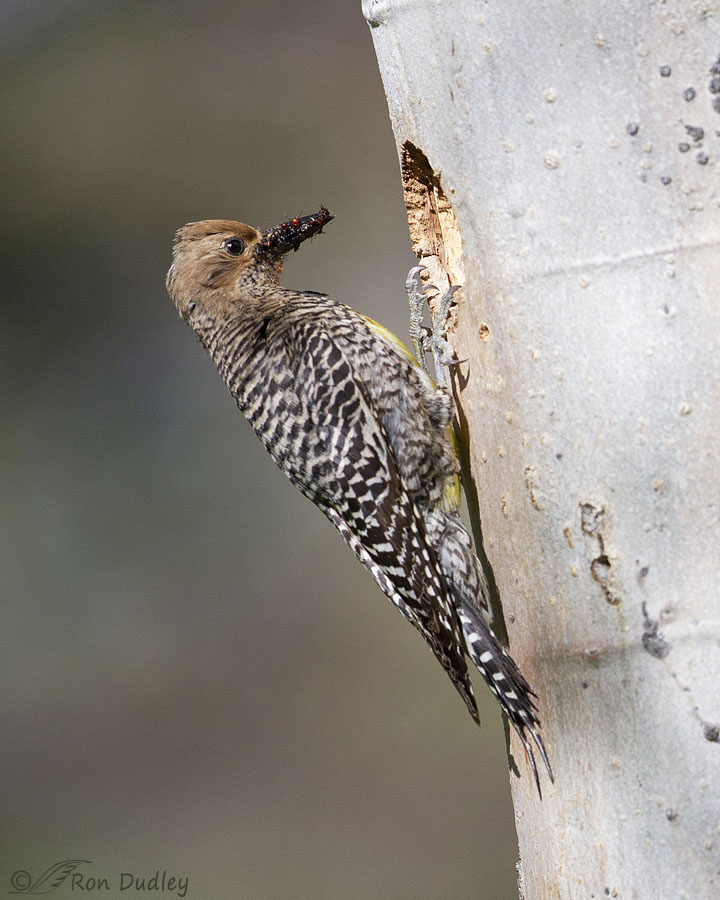
This is the female of the pair delivering a beak-load of ants to their chicks in the nest cavity. Most ant-foraging birds regurgitate food to their young but Williamson’s Sapsuckers carry the (often still living) insects in their throat, mouth and bill. Sometimes they were carrying more ants than this.
Notice the two extra-stiff and long tail feathers that assist in allowing woodpeckers to brace themselves against their near-vertical perches.
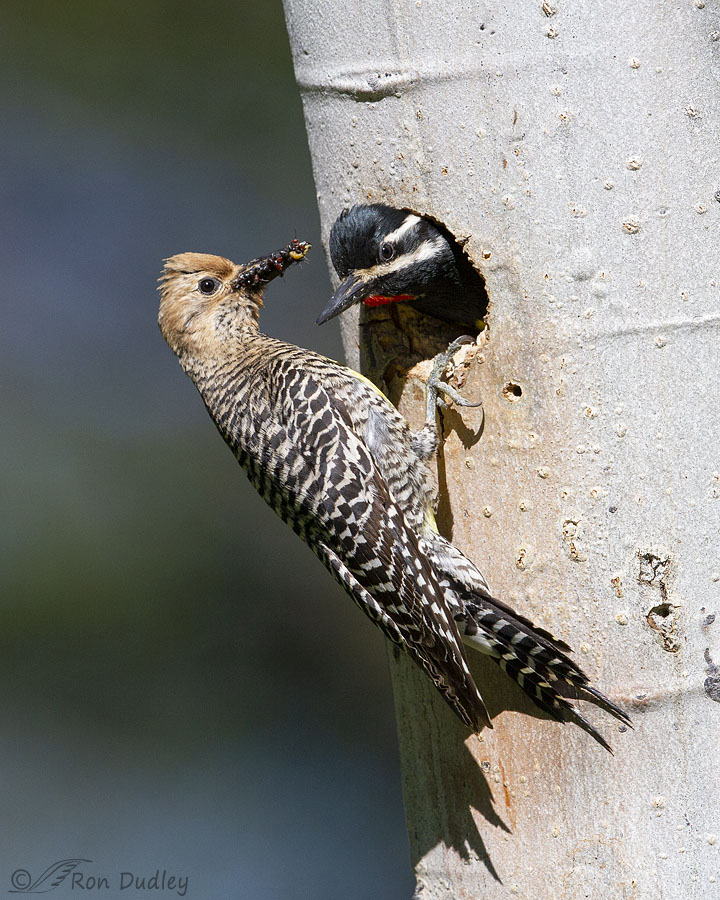
Those chicks ate a lot of ants! When they’re this age their parents, between the two of them, average about one feeding trip to the nest every three minutes, all day long. There may be as many as 7 (most often 4-6) growing chicks inside the nest cavity so you can imagine how many insects, mostly tiny ants, they require.
As a result one of the adults was often still inside the nest cavity when the other one arrived with another load of ants. When that happened the newly arrived adult had to lean far to one side to allow room for its mate to explosively leave the cavity.
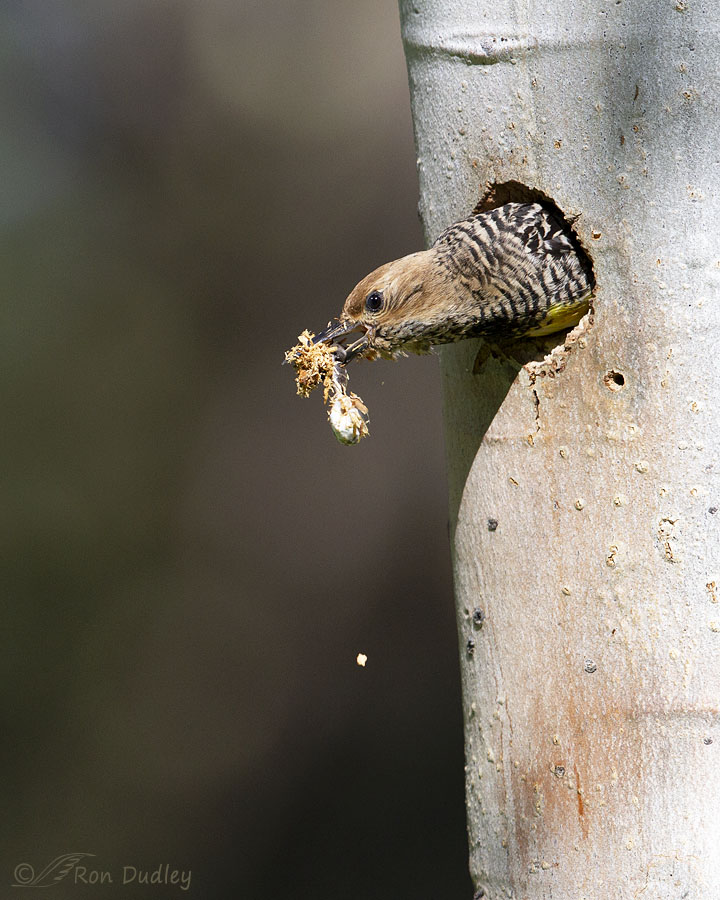
The adults enlarge the interior of the cavity as the chicks grow (I could often hear their hammering) so that means there’s lots of wood chips to remove. Here the female is removing chips and a single fecal sac. Usually the chips and fecal sacs were carried far away from the nest tree before being discarded.
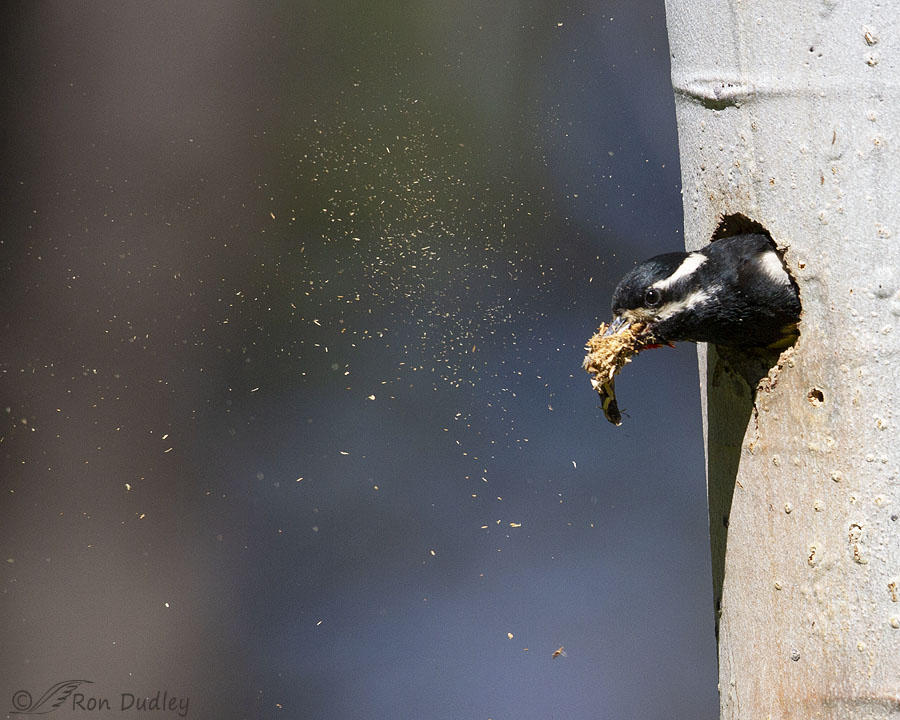
But sometimes the male in particular got lazy and dropped them from the opening to the cavity. Typically he’d open his beak and shake his head and the chips would go flying. But this time he appeared to be undecided about his technique because he shook his head without opening his beak so only some of the chips went flying. I’ve posted this photo before but in this context I thought it deserved to be seen again.
I can’t imagine how much the adults must have looked forward to becoming empty-nesters again. For me it was exhausting just to watch them but it was also a hell of a lot of fun..
Ron


As always, your comments/story are always a learning experience and a the photo captures so wonderful. Linda
Wonderful observation and comments. I would like to find a photographer who would spend enough time to see what you see.
Wonderful series, I did not know they continued to enlarge the nest space in the tree as the offspring grew.
April, I was surprised how often we could hear them chipping away in there with the chicks inside. And they kept kept disposing of more wood chips.
Wow, these are wonderful, Ron. The pic of the two together is … “one for the books,” as they used to say (a VERY long time ago!).
Thanks, Ellen. I still say it.
I wonder whether the male got an earful for his throw and go (thanks Arwen) technicque.
Every three minutes???? Colour me awed. And exhausted.
Yup, every three minutes on average when the chicks get a little larger but are still in the cavity. I double checked that stat on Cornell before I posted it because it seemed almost unbelievable so I was afraid I might have remembered it wrong.
Very interesting and informative. You tell a good story, Mr. Dudley, in both words and pictures.
You have the Willamson’s, we have the Red-breasted, both of us have the Red-naped (rare sighting here). Guess that makes us almost even.
Thank you, Lyle. Yes, it’s a draw or very close to it.
No wonder I can’t identify female sapsuckers! The difference is amazing. So fun to see these hard workers.
This is the only sapsucker species where it’s this easy to tell the difference, Catherine. Thanks.
What a fun series – and yes am exhausted too thinking about every 3min delivery schedule all day long!
Thank you, Kathleen.
Would the ants be attracted to the sap that the sapsuckers eat ? That would make a “two-fer ” in a nutritious trip……reminds me of that old “saw” ;
I eat my peas with honey, I’ve done it all my life–it makes the peas taste funny but it sticks ’em to the knife”—-or ants to beak, as the case may be !
“Would the ants be attracted to the sap that the sapsuckers eat ?”
My guess would be no, Kris. Too sticky. Makes me think of the ancient ants we find to this day engulfed in amber from millions of years ago..
But sapsuckers sometimes take a load of ants to their sap wells and dip them in sap before delivering them to their chicks. I occasionally see ants actively crawling over the bills and faces of the sapsuckers.
Dipping your peas in glue would have the same effect – the peas would stick to your knife and they’d taste funny. Just a thought…
Wow…what a male/female difference. I can certainly see how two species could be in someone’s mind…seems like just the yellow belly is shared. Nice catch with the sawdust in the air. I wish the grackles would adapt the ‘drop’ method of house cleaning those fecal sacs instead of flying the same route over my patio. It is amazing how the route will only vary by a few inches.
It is amazing how the route will only vary by a few inches.
That’s interesting about your grackles, Kathy. Creatures of habit, just like me.
Laughing at Arwen’s “throw and go” comment. A humorous and accurate description of the male’s efforts.
Excellent photos and very educational post.
I have never seen a Williamson’s here. We show them as uncommon/transient very low numbers mostly in winter. I will have to look harder.
Thanks, Everett. Arwen does tend to have a way with words.
Great series, Ron… The idea of all those ants crawling on my face…….
The idea of all those ants crawling on my face……. Certainly not much grub per ant for the chicks and that’s a LOT of mouths to feed.. Interesting how different the male/females are tho logical for the female to blend into the woodwork so to speak…thinking of the Downey/Hairy Woodpeckers here whose only difference is the red cap and the Northern Flickers in the “darned if I know” category. Capturing the sawdust flying IS fun.
Certainly not much grub per ant for the chicks and that’s a LOT of mouths to feed.. Interesting how different the male/females are tho logical for the female to blend into the woodwork so to speak…thinking of the Downey/Hairy Woodpeckers here whose only difference is the red cap and the Northern Flickers in the “darned if I know” category. Capturing the sawdust flying IS fun.
“The idea of all those ants crawling on my face”
Or in our mouths! Just the thought of all those ant bites and all that formic acid in my mouth makes me squirm. Thanks, Judy.
I’m amused by the male’s “throw and go” method. I’ll be adopting that for my housecleaning from here forward.
Whatever works…
Me too.
Yes! Exhausting! Tremendously enjoyed this informative post as I’ve seen sapsuckers where I lived in East TX for 28 yrs (among many other tree-climbing birds in the Piney Woods of East Texas) but couldn’t observe their chick-rearing habits.
as I’ve seen sapsuckers where I lived in East TX for 28 yrs (among many other tree-climbing birds in the Piney Woods of East Texas) but couldn’t observe their chick-rearing habits.
Glad you enjoyed it. Thanks, Terri.